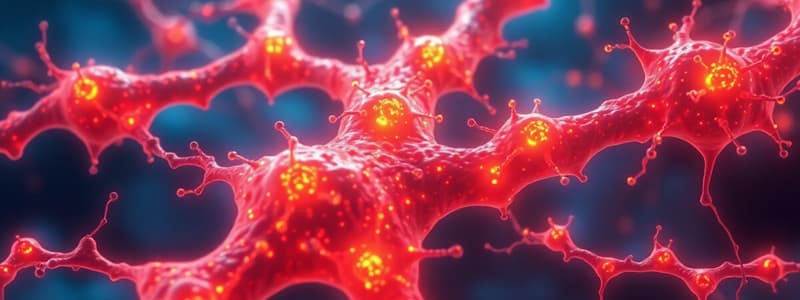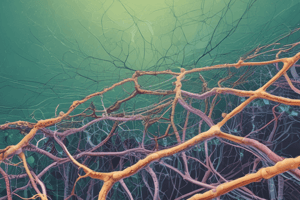Podcast
Questions and Answers
What is the primary function of occluding junctions?
What is the primary function of occluding junctions?
- To facilitate intercellular exchange of substances.
- To prevent intercellular exchange of substances. (correct)
- To provide mechanical attachment between cells.
- To enable communication between cells via chemical synapses.
Which of the following is a component of tight junctions?
Which of the following is a component of tight junctions?
- Occludin (correct)
- Integrins
- Connexins
- Cadherins
What is the main function of gap junctions?
What is the main function of gap junctions?
- Attaching cells to the extracellular matrix.
- Allowing direct communication between adjacent cells. (correct)
- Preventing paracellular transport.
- Creating a strong mechanical link between cells.
Which structure do tight junctions form in brain capillaries?
Which structure do tight junctions form in brain capillaries?
What is another name for gap junctions?
What is another name for gap junctions?
Which of the following best describes the 'gate function' of tight junctions?
Which of the following best describes the 'gate function' of tight junctions?
What is the role of CAMS (Cell Adhesion Molecules)?
What is the role of CAMS (Cell Adhesion Molecules)?
Which of the following is NOT a type of cell adhesion molecule?
Which of the following is NOT a type of cell adhesion molecule?
What is the function of Adherens junctions?
What is the function of Adherens junctions?
What do anchoring junctions do?
What do anchoring junctions do?
What is the role of integrins in cell junctions?
What is the role of integrins in cell junctions?
What type of cell junction is present in heart muscle?
What type of cell junction is present in heart muscle?
Which of the following diseases is associated with mutations in genes encoding connexins?
Which of the following diseases is associated with mutations in genes encoding connexins?
What is the function of tight junction membrane proteins?
What is the function of tight junction membrane proteins?
What is the result of increase in intracellular calcium ions regarding diameter of the channel?
What is the result of increase in intracellular calcium ions regarding diameter of the channel?
What is the molecular weight range of small molecules?
What is the molecular weight range of small molecules?
What type of cell does hemidesmosome connect?
What type of cell does hemidesmosome connect?
What happens in the colon if there is a dysfunction of adherens or focal junctions?
What happens in the colon if there is a dysfunction of adherens or focal junctions?
Which of the following proteins are primarily involved in desmosomes?
Which of the following proteins are primarily involved in desmosomes?
What is the function of the plaque proteins in desmosomes?
What is the function of the plaque proteins in desmosomes?
Flashcards
Cell Junctions
Cell Junctions
Junctions between two neighboring cells; also called intercellular junctions.
Intercellular Junction Examples
Intercellular Junction Examples
Tight junctions, gap junctions, adherence junctions, and desmosomes.
Examples of Membrane Junctions
Examples of Membrane Junctions
Focal adhesion and hemi-desmosomes.
Occluding Junctions
Occluding Junctions
Signup and view all the flashcards
Occluding Junction Location
Occluding Junction Location
Signup and view all the flashcards
Tight Junction Structure
Tight Junction Structure
Signup and view all the flashcards
Tight Junction Membrane Proteins
Tight Junction Membrane Proteins
Signup and view all the flashcards
Functions of Tight Junctions
Functions of Tight Junctions
Signup and view all the flashcards
Tight Junctions in the Brain
Tight Junctions in the Brain
Signup and view all the flashcards
Types of Communicating Junctions
Types of Communicating Junctions
Signup and view all the flashcards
Gap Junctions
Gap Junctions
Signup and view all the flashcards
Chemical Synapse
Chemical Synapse
Signup and view all the flashcards
Gap Junction Dysfunction
Gap Junction Dysfunction
Signup and view all the flashcards
Anchoring Junctions
Anchoring Junctions
Signup and view all the flashcards
Actin Filament Attachments
Actin Filament Attachments
Signup and view all the flashcards
Intermediate Filament Attachments
Intermediate Filament Attachments
Signup and view all the flashcards
Adherens Junction
Adherens Junction
Signup and view all the flashcards
Role of Cadherins
Role of Cadherins
Signup and view all the flashcards
Focal Adhesion
Focal Adhesion
Signup and view all the flashcards
Types of Cell Adhesion Molecules
Types of Cell Adhesion Molecules
Signup and view all the flashcards
Study Notes
- Cell junctions facilitate connection between neighboring cells.
- They are also called intercellular junctions.
- Examples of intercellular junctions: tight junctions, gap junctions, adherens junctions, and desmosomes.
- Contact between the cell and extracellular matrix is called membrane junction.
- Examples of membrane junctions: focal adhesion and hemidesmosome.
Classifications of Junctions
- Junctions are classified into three types: occluding, communicating, and anchoring junctions.
Occluding Junctions
- These junctions prevent intercellular exchange of substances.
- Tight junctions belong to the category of junctions that prevent movement of ions and molecules from one cell to another.
- Occluding junctions are divided into tight junctions.
Tight Junctions
- Also called zonula occludens.
- They prevent passage of large molecules.
- Present in the apical margins of epithelial and endothelial cells in intestinal mucosa, wall of renal tubule, capillary wall, and choroid plexus.
- A tight junction is made up of a ridge which has two halves (from the two cells).
- The ridge is formed by tight junction strands made up of proteins.
Proteins of Tight Junctions
- Tight junction membrane proteins or integral membrane proteins: occludin, claudin, JAMs (junctional adhesion molecules).
- Scaffold proteins or peripheral membrane proteins or cytoplasmic proteins.
- Plaque proteins: cingulin, symplekin, and ZO-1,2,3.
- Based on its function, it is called an impermeable junction.
Functions of Tight Junctions
- Functions as a selective diffusion barrier between neighboring epithelial or endothelial cells; this is referred to as a barrier or gate function.
- Forms a selective barrier for small molecules and a total barrier for large molecules.
- Tight junctions in brain capillaries form the blood-brain barrier (BBB).
- Maintains the differential composition of proteins and lipids between the apical and basolateral plasma membrane domains.
Communicating Junctions
- Permit intercellular exchange of substances and are divided into gap junctions and chemical synapses.
Gap Junction
- Also called nexus.
- Allows passage of ions and small molecules between neighboring cells.
- It is present in the heart, basal part of epithelial cells of intestinal mucosa, etc.
- Each half of the channel is surrounded by six subunits of proteins called connexins or connexons.
- Diameter of the channel in gap junction is about 1.5 to 2.0 nm.
- The diameter of each channel is regulated by intracellular calcium ions; increased intracellular calcium ions decreases the diameter of the channel.
Chemical Synapse
- The junction between a nerve fiber and a muscle fiber, or between two nerve fibers, through which signals are transmitted by the release of chemical transmitters.
Applied Physiology
- Mutation to the genes encoding connexins causes diseases such as deafness, keratoderma, cataract, Charcot-Marie-Tooth disease, and Heterotaxia.
Anchoring Junctions
- They provide strength to the cells by acting like mechanical attachments.
- Responsible for the structural integrity of tissues and are present in heart muscles, epidermis of skin, etc.
- Anchoring junctions are divided into actin filament attachment and intermediate filament attachments.
Actin Filament Attachment
- Adherens junction
- Focal adhesion
Intermediate Filament Attachment
- Desmosome
- Hemidesmosome
Adherens Junction
- This is cell-to-cell junction, which connects the actin filaments of one cell to those of another cell.
- This junction forms a continuous adhesion (zonula adherens) just below the tight junctions.
- The membranes of the adjacent cells are held together by transmembrane proteins called cadherins.
- Adherens junctions are present in the intercalated discs between the branches of cardiac muscles.
Focal Adhesion
- This cell-to-matrix junctions, which connects the actin filaments of the cell to the extracellular matrix.
- The transmembrane protein that holds the cell membrane and the matrix are called integrins.
Desmosome
- This is a cell-to-cell junction where intermediate filaments connect two adjacent cells.
- It is also called macula adherens.
- They function like tight junctions.
- Proteins involved in desmosomes are mainly cadherins.
Hemidesmosome
- This is a cell-to-matrix junction, which connects the intermediate filaments of the cell to the extracellular matrix.
- It is also called half-desmosome.
- The proteins involved here are integrins.
Applied Physiology
- Dysfunction of adherens junction and focal junction in the colon due to mutation of protein results in colon cancer.
- It also leads to tumor metastasis.
- Dysfunction of desmosome causes bullous pemphigoid (autoimmune disease).
- Dysfunction of hemidesmosome also causes bullous pemphigoid.
Cell Adhesion Molecules (CAMs)
- CAMs are protein molecules responsible for the attachment of cells to their neighbor or to basal lamina.
- These molecules form the important structures of intercellular connections and are responsible for structural organization of tissues.
Types of Cell Adhesion Molecules
- Cadherins, which form the molecular limbs between neighboring cells.
- Integrins, which form the focal adhesions and hemidesmosomes.
- Immunoglobulin (Ig) superfamily, which forms the cell adhesion molecules.
- Selectins, which act as receptors for carbohydrate ligands and are found in platelets and endothelial cells.
Studying That Suits You
Use AI to generate personalized quizzes and flashcards to suit your learning preferences.



